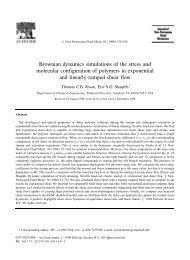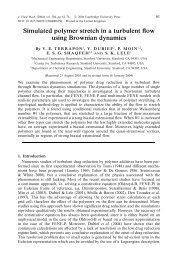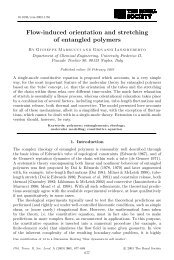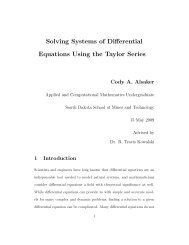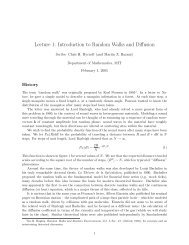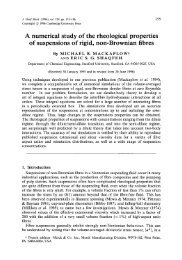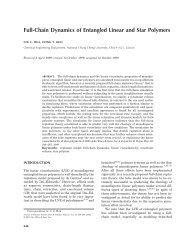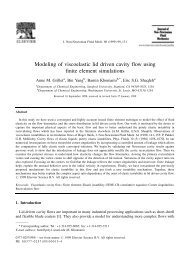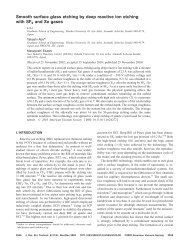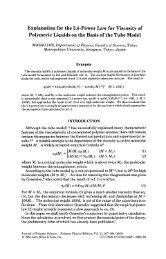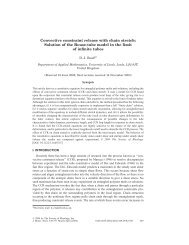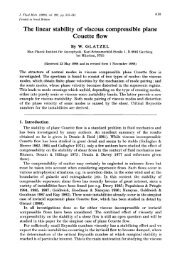Molecular modelling of entangled polymer fluids under flow The ...
Molecular modelling of entangled polymer fluids under flow The ...
Molecular modelling of entangled polymer fluids under flow The ...
Create successful ePaper yourself
Turn your PDF publications into a flip-book with our unique Google optimized e-Paper software.
2.4. CHAIN STRETCH AND CONSTRAINT RELEASE 31<br />
basic DE model. <strong>The</strong> inclusion <strong>of</strong> stretch improves transient predictions in start-up <strong>of</strong><br />
shear in several ways. <strong>The</strong> DEMG model predicts transient overshoots in shear stress<br />
and normal stress which grow in size with shear rate. In addition, the strain at peak<br />
stress <strong>of</strong> these overshoots increases with shear rate. All <strong>of</strong> these features are observed<br />
experimentally. <strong>The</strong> DEMG theory is less successful in steady shear. In many circumstances<br />
the shear stress maximum remains. In fact, any approach which merely<br />
adds chain stretch, relaxing via Rouse retraction, to the DE theory is doomed to suffer<br />
a similar fate. <strong>The</strong> reasons for this are two-fold. In rapid shear <strong>flow</strong>s the DE orientation<br />
tensor predicts strong steady state chain alignment along the shear direction.<br />
As a consequence, the highly aligned chains present a very slim pr<strong>of</strong>ile to the velocity<br />
gradient and so predicted steady state stretch values are modest even at high stretch<br />
Weissenberg numbers (W s = ˙γτ R ). A more fundamental problem is that the separation<br />
<strong>of</strong> orientation time, τ d , and stretch time, τ R , is fixed at 3Z. Hence if Z is set to a large<br />
enough value the onset <strong>of</strong> chain stretch is delayed to shear rates well in excess <strong>of</strong> 1/τ d<br />
and the bare DE behaviour, including the stress maximum, is recovered at shear rates<br />
around 1/τ d . <strong>The</strong> degree <strong>of</strong> entanglement necessary to see this effect is within the range<br />
<strong>of</strong> existing experiments.<br />
A second possible solution is constraint release. This is an additional relaxation<br />
mechanism which recognises that whenever a chain end passes through a tube segment<br />
the constraint that was imposed by this chain on a neighbouring chain is lost. Hence<br />
the neighbouring chain is free to explore a wider region via lateral motion (see figure<br />
2.11). Constraint release is a self consistent closure <strong>of</strong> the mean field approximation <strong>of</strong><br />
Figure 2.11: Schematic representation <strong>of</strong> a constraint release event.<br />
the tube model. In the linear regime constraint release events are caused by reptation<br />
<strong>of</strong> the surrounding chains. This is known as reptative or thermal constraint release.<br />
Since reptative constraint release occurs on the time-scale <strong>of</strong> the reptation time <strong>of</strong> the<br />
whole chain and one event only relaxes a small part <strong>of</strong> the chain, Doi and Edwards



